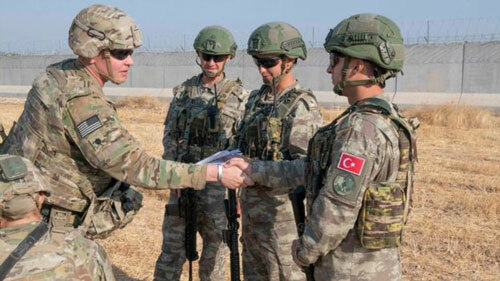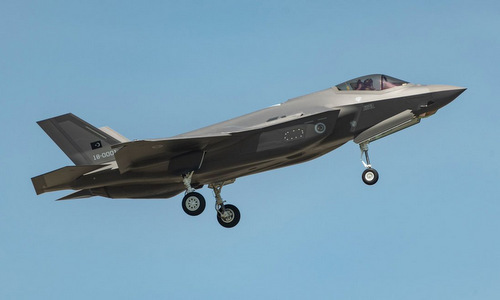The US has not stopped Turkey from attacking Syria possibly to salvage its F-35 fighter program and restore bilateral relations.
US President Donald Trump in a phone call last week with his Turkish counterpart Recep Tayyip Erdogan agreed to withdraw about 50 US troops stationed on the northern border of Syria, in order to create conditions for Turkey to bring troops down. south, starting the Spring Peace campaign against the Kurdish militia.

US troops (left) shake hands with Turkish soldiers in northeastern Syria in early October Photo: BBC
A senior US defense official, who declined to be named, said the Pentagon will withdraw nearly all troops in Syria in the next few weeks, leaving only a small garrison at Al Tanf base near the border. Jordan. This move will in fact end the US military presence in Syria after 5 years of pouring money from the Islamic State (IS) rebels in this country.
From October 14, US special forces began to withdraw quickly from the outposts on the Syrian border, ceding control of strategic areas to Syrian and Russian government troops. Analysts say Washington has a lot of momentum behind the decision, though they could harm US influence in the long run.
Ali Demirdas, a political science expert at the University of South Carolina in the United States, said one of the leading causes of the U.S. ignoring the Turkish offensive was the F-35 super fighter project.
Senator Lindsey Graham, close ally of US President Donald Trump, revealed last month that Washington was seeking to bring Ankara back to the F-35 super-fighter program. This statement surprised many because Turkey was excluded from the project in July, the US Congress also repeatedly threatened to apply the US Anti-Rival Act through the Embargo (CAATSA) to protest the Ankara bought S-400 anti-aircraft missiles from Moscow.
The United States and Turkey have experienced disagreements on several occasions, especially when Washington backed the Kurdish People's Protection Units (YPG) in Syria, a force considered by Ankara to be a terrorist organization and a security threat. Top.

Turkey's first F-35A fighter jet flew in June Photo: USAF
The intention to apply the CAATSA law of the United States faced a fierce response when Turkey threatened to retaliate with a large-scale attack on the YPG-controlled area in Syria and establish a safe zone.
Washington sent a special envoy to Syria to Turkey in August to prevent Ankara from attacking YPG. Trump and Erdogan also agreed to increase bilateral trade to $ 75 billion at the sidelines of the G20 summit in Japan. These moves are all aimed at persuading Ankara to abandon military action and to join joint patrols with Washington along the Turkish-Syrian border.
The proposal to bring Turkey back to the F-35 project is seen as a final attempt to persuade Ankara not to destroy the "YPG project" that the Pentagon has been working on over the past five years. On the other hand, this move is also seen as an effort to salvage the most expensive fighter program in history when one of the key partners was dismissed from the project.
The F-35 program has been repeatedly criticized for being too expensive and slow to schedule. Despite the investment of US $ 1,500 billion, the super-fighter line has always experienced technical problems affecting its ability to operate, not to mention many incidents that threaten flight safety.
Lockheed Martin has a lot of difficulties finding customers to offset costs. Earlier this year, Germany canceled its purchase of the F-35 and switched to Typhoon fighter. The F-35 program continues to be threatened by a series of joint venture development projects such as FCAS of France - Germany - Spain or Tempest of England, Italy and Sweden.
Prior to being excluded from the project, Turkey was the third most ordered nation of F-35 fighters, second only to the United States and Japan. "It would be unwise to dismiss the country of ordering more than 100 aircraft in the context that the US could lose a lot of potential markets," Demirdas said.
The F-35 program itself has serious problems with the spare parts production line. The US Government Audit Office (GAO) in April warned that only 27% of F-35 fighters globally were capable of performing the mission, much lower than the minimum requirement of 60%.
The reason is that the F-35 fighters are constantly being revised and upgraded, causing incompatibility with the original parts. Retaining Turkey to the project became even more urgent as the aviation industry produced more than 900 key components of the F-35, including a body frame, landing gear and cockpit glass.
"F-35 contracts will continue to be delayed and costly if Turkey is excluded from the project," said Ellen Lord, US Defense Undersecretary for Equipment Procurement and Maintenance.
President Trump emphasized the importance of Turkey to the F-35 program, saying that it is a major US trading partner. "Recent US actions have shown that they are seeking to resolve disagreements with Turkey, one of the most important partners and allies in the world," Demirdas said.



 SergeNekipelov
SergeNekipelov







